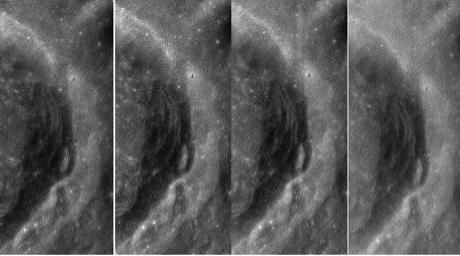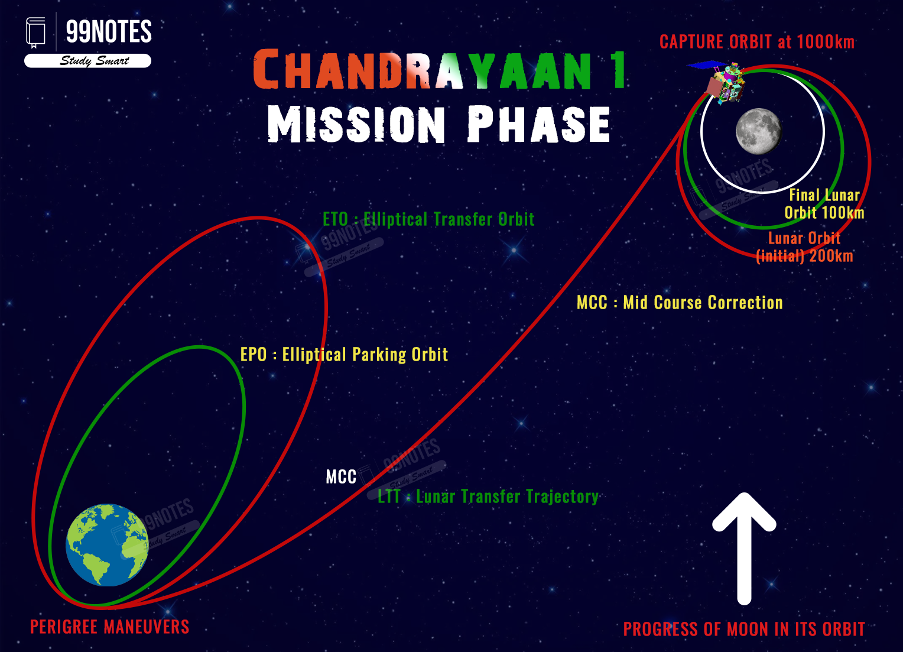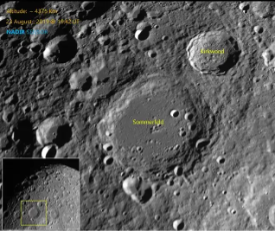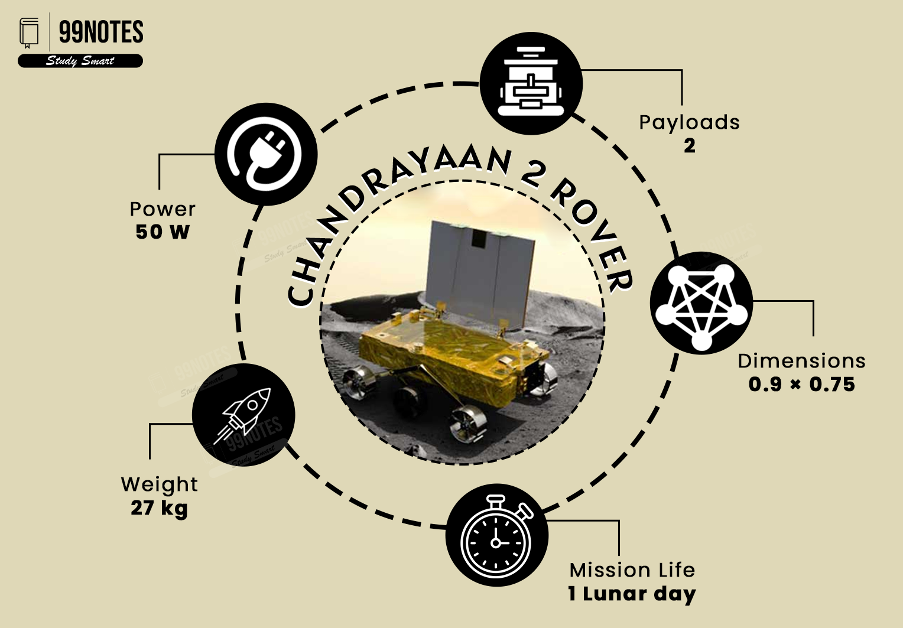The Chandrayaan Programme
Chandrayaan Programme, also known as the Indian Lunar Exploration Programme, is an ongoing series of missions to the Moon to unravel the mysteries of the Moon and contribute to the understanding of the international space community in terms of lunar geology, atmosphere, and resources. There have been 3 such missions involving orbiters, Landers, Rovers and impact Probe. Several future missions under this programme are at the planning stage.
Chandrayaan-1
Chandrayaan-1 was the first lunar Probe in the Indian Lunar Exploration Programme. It was also the first Indian deep space mission. Launched on 22 October 2008 aboard a PSLV-XL rocket, the Probe reached the lunar orbit on 8 November 2008. The Mission ended after 10 months (well before the mission duration) after the contact was lost on 28 August 2009.
Mission Objectives
The Mission had the following objectives:
- To design, develop, and launch a spacecraft around the orbit on the Moon using an Indian rocket.
- To conduct scientific experiments and data collection, which would include:
- 3D mapping of lunar surface at a high resolution.
- Simultaneous Mineralogical, chemical and photo-geological mapping of the Moon at better resolution than any current or planned probe.
- Estimation of lunar surface mineral composition and concentration (Mg, Al, Ca, Ti, Si, Fe).
- To look for sub-surface, surface lunar water ice, especially at the poles.
- To test the impact of a probe on the surface of the Moon as a testbed for future lunar missions involving hard and soft landings.
Instruments
The Probe carried 11 different instruments for multidimensional scientific analysis of the Moon. Besides 5 Indian instruments, the Probe also carried 6 instruments from the USA, UK, Germany, Sweden and Bulgaria, weighing 90 Kg.
Terrain Mapping Camera (TMC)
(De Roy crater captured by the TMC)
These instruments aimed to map the near and far sides of the Moon and create a 3D atlas of the Moon with high spatial and altitude resolution. It worked in a visible range of the electromagnetic spectrum. It was developed by the ISRO’s Space Application Centre.
Hyperspectral imager (HySI)
It aimed to obtain spectroscopic data of the Moon’s surface. Data generated by this instrument can help in studying the mineral composition of the Moon’s surface and understanding the mineral composition of the lunar interior.
Image of Rimaegassendi by HySI
Moon Impact Probe
It was a piggyback ride on the Chandrayaan-1 orbiter and was released from a height of 100 km on the Southern pole (89.76°S 39.40°W). It had an instrument named CHACE (a mass spectrometer to measure the constituents of the lunar atmosphere). This instrument was credited for discovering hydroxyl ions on the surface of the Moon. The impact point (near the rim of the Shackleton crater) has been named Jawahar Point.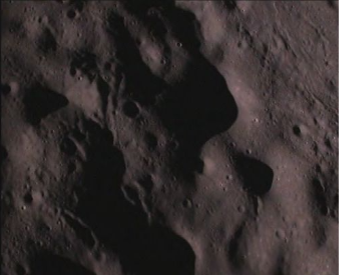
Image taken by the Moon Impact probe
Sources of water on the Moon
Moon could have gotten water from three sources:
- The Primordial rocks from which both Earth and Moon were formed.
- Water-bearing comets that have hit the Moon for billions of years.
- Hydrogen ions in solar wind chemically combine with Oxygen atoms present in the lunar mineral surface.
Moon Mineralogy Mapper
It was an imaging spectrometer developed by the Brown University for NASA. It was meant to characterise and map the lunar mineralogy in the context of lunar geologic evolution by studying highland crust, basaltic volcanism and impact Probe. It is credited for discovering water molecules on the polar surface of the Moon.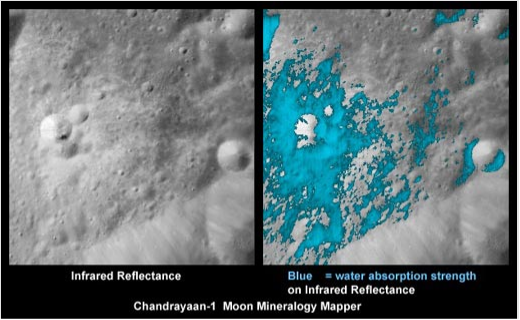
Other Instruments
Other instruments on the Chandrayaan-1 moon probe included:
- Lunar Laser Ranging Instrument (LLRI)
- High Energy X-ray spectrometer (HEX)
- Chandrayaan-1 X-ray spectrometer (C1XS)
- Near IR Spectrometer (SIR-2)
- Miniature Synthetic Aperture Radar (MiniSAR)
- Sub KeV Atom Reflecting Radar (SARA)
- Radiation Dose Monitoring Experiment (RADOM)
Mission Timeline
End of the Mission
The Mission ended after the contact was lost on 28 August 2009. The Probe worked for 10 months, well short of the estimated mission life of 2 years. The premature end of life was attributed to faulty DC-to-DC converters.
Scientific Achievements of the Chandrayaan-1 Probe
- The most significant result from Chandrayaan-1 is the discovery of the presence of hydroxyl (OH) and water (H2O) molecules on the lunar surface. The data from the Moon Mineralogy Mapper (M3) revealed the abundance of water molecules in the Polar region.
A three-colour composite of near-infrared reflected solar radiation for the lunar nearside by M3. The blue colour indicates the signature of OH/H2O, and the red colour indicates the presence of iron-bearing minerals.
- Data from the M3 instrument of the Chandrayaan-1 proved the Magma Ocean hypothesis, indicating that the Moon was once completely molten.
- The instruments on board the Probe have provided high-resolution spectral data of the mineralogy of the Moon.
Chandrayaan-2
It is the second lunar Mission of ISRO after Chandrayaan-1. Unlike Chandrayaan-1, which consisted of only an orbiter, its successor consisted of a lunar orbiter, a lander named Vikram and a rover named Pragyan.
The Mission was launched aboard an LVM3 (GSLV MK3) rocket on 22 July 2019 from the second Launchpad of Satish Dhawan Space Centre. The spacecraft reached the lunar orbit on 20 August 2019. The Lander was supposed to soft-land on 6 September 2019; however, it crash-landed on the Moon’s surface during its crucial fine-braking phase. 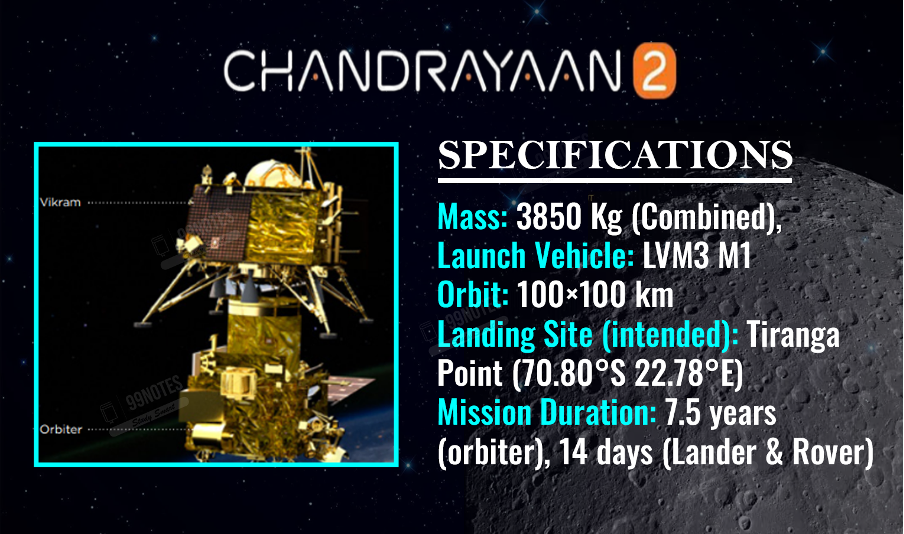
Historical Background
Earlier, India had signed a deal with Russian Space Agency Roscosmos in 2007 for a joint collaboration for a successive mission to the Moon after Chandrayaan-1. ISRO was to provide the orbiter, the rover and the launch vehicle for the Mission, whereas Roscosmos was to provide a lander. However, due to delays from the Russian side and the failure of Roscosmos’ Fobos-Grunt mission, India decided to go independently.
Mission Objectives
The Mission intends to expand the lunar scientific understanding through a detailed study of topography, seismography, mineral composition and distribution, surface chemical composition, thermo-physical characteristics of lunar topsoil and composition of the sparse lunar atmosphere.
- The orbiter aimed to study lunar topography, mineralogy, lunar exosphere, and signature of hydroxyl and water ice and to prepare a 3D atlas of the Moon.
- The primary Mission of the Lander and the rover was to demonstrate soft landing on the Moon’s South Pole region, operate a rover on the surface and conduct in-situ scientific experiments.
Mission Timeline and Profile
Instruments
The orbiter had 8 scientific payloads, the Lander consisted of 3 scientific instruments and 1 passive payload from NASA, and the rover had 2 scientific instruments.
Orbiter
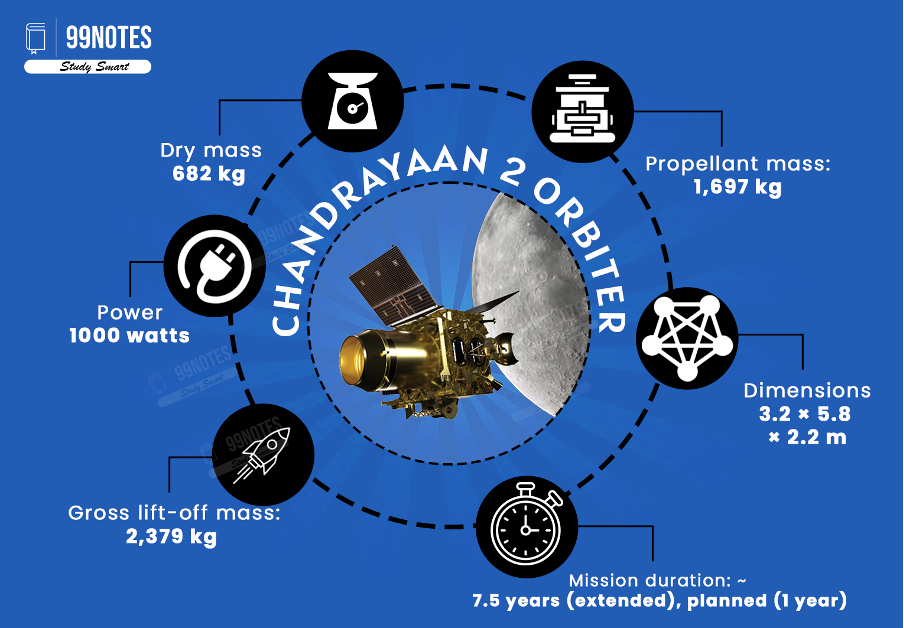
- Terrain Mapping Camera-2 (TMC-2): This is supposed to generate the digital elevation model of the entire Moon, which is essential for studying the Moon’s geology and its evolution.
- Orbiter High-Resolution Camera (OHRC): The primary objective of this payload was to take high-resolution images of the landing site. Post-separation of the Lander, it is supposed to do scientific research. It is the highest resolution (0.32m) camera currently in the lunar orbit.
- Chandrayaan-2 Large Area Soft X-Ray Spectrometer (CLASS): It measures the Moon’s X-ray Fluorescence spectra to investigate the presence of major elements such as Magnesium, Aluminium, Iron, Sodium, Silicon, Calcium and Titanium. The XRF technique will detect these elements by measuring the characteristic X-rays they emit when excited by the Sun’s rays.
- Dual Frequency X-Ray Monitor: It penetrates the Moon’s surface a few metres to determine the constituent elements. It operates in both L-band and S-band
- X-Ray Solar Monitor (XSM): It observes the X-rays emitted by the Sun and its corona, assesses its solar radiation intensity, and provides inputs to the CLASS instrument.
- Imaging IR Spectrometer (IIRS): It maps the Moon’s surface over a wide wavelength for the study of minerals, hydroxyl ions and water molecules.
- Chandrayaan-2 Atmospheric Compositional Explorer-2 (CHACE-2): It is a successor to the CHACE experiment on the previous orbiter. It is a mass spectrometer that aims to carry out an in-situ study of the composition and distribution of the lunar exosphere and its variability.
- Dual Frequency Radio Science Experiment (DFRS): It aims to study the temporal evolution of the electron density in the lunar ionosphere.
Lander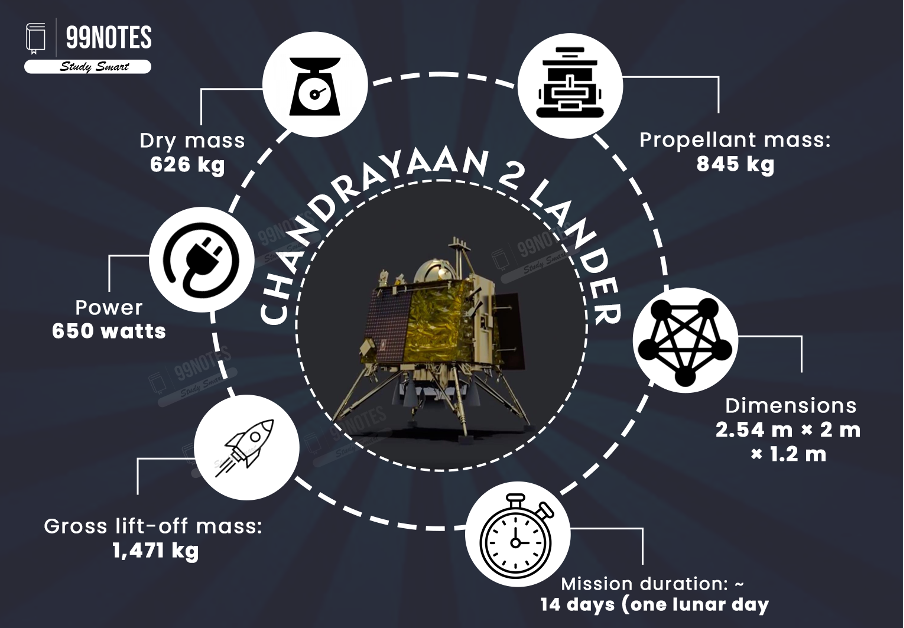
The Lander had 4 scientific instruments; however, it failed to soft-land and crash-landed on the moon’s surface, destroying its scientific instruments. However, the same set of instruments was sent on its successor mission, Chandrayaan-3.
- Radio Anatomy for Moon-bound Hyper-sensitive Ionosphere and Atmosphere (RAMBHA): It is a Langmuir probe (to measure electron temperature, density and electric potential of Plasma) to study the density and variation of lunar surface plasma.
- Instrument for Lunar Seismic Activity (ILSA): ILSA is a triple axis, MEMS (Microelectromechanical systems) based seismometer that can detect minute ground displacement, velocity, or acceleration caused by lunar quakes. Its primary objective is to characterise the seismicity around the landing site.
- Chandra’s Surface Thermo-physical Experiment (CHaSTE): It measures the vertical temperature and thermal conductivity of the lunar surface.
- Laser Retroreflector Array: It is a passive experiment by NASA to accurately measure the distance between the Moon’s surface and the orbiter. Further, it can provide accurate distance between the Earth and moon by using a bigger LRA on the orbiter.
Rover
The rover had two scientific instruments; however, it got destroyed with its parent craft, Vikram Lander. However, the same set of instruments are aboard the Chandrayaan-3 mission, which has successfully made a soft landing on the Moon.
- Alpha-Particle X-ray Spectrometer (APXS): The primary objective of this instrument is to study the elemental composition of the Moon’s surface. It employs an X-ray fluorescence spectroscopy technique in which alpha particles or X-ray is emitted to excite the Moon’s surface and detects the constituent element.
- Laser-Induced Breakdown Spectroscope (LIBS): It aims to identify and determine the abundance of minerals near the landing site by firing laser pulses and analysing the radiation emitted by the decaying Plasma.
Why did the landing fail?
The failure was mainly attributed to a software glitch that failed to take into account the extra thrust generated by the Lander’s propulsion. As per S. Somnath, the ISRO chief, “Our ability to handle parameter variation and dispersion was very limited”. A smaller landing area (500m×500m) was also one of the reasons for failure.
Scientific Findings
- Detection of Sodium: The Chandrayaan-2 Large Area Soft X-Ray Spectrometer (CLASS) instrument spotted and identified an abundance of Sodium on the Moon’s surface.
- Detection of hydroxyl and water molecules: The Imaging Infrared Spectrometer (IIRS) instrument of the orbiter detected the unambiguous presence of hydroxyl (OH) and water molecules (H2O). The scientists also found out that the sunlit regions of higher latitudes on the Moon had higher concentrations of hydroxyl and water molecules.
- Distribution of Argon-40 in Lunar Exosphere: The Chandrayaan-2 Atmospheric Compositional Explorer-2 (CHACE-2) instrument made observations related to the distribution of Argon-40 in higher latitudes.
- Solar flares: The X-Ray Solar Monitor (XSM) on board the orbiter has witnessed a large amount of microflares outside the inactive regions of the Sun for the first time.
- Presence of Cr, Mg: The CLASS instrument detected the presence of Chromium and Magnesium on the lunar surface.
Chandrayaan-3 Mission
It is a follow-up mission to the Chandrayaan-2 mission of the ISRO under the Chandrayaan Programme. The Mission is quite similar to its predecessor, Chandrayaan-2, except this Mission does not include a functional orbiter. The Lander and Rover have the same set of scientific instruments as the previous one.
The Mission was launched aboard a LVM3-M4 rocket on 14 July 2023. The spacecraft was inserted in the lunar orbit on 5 August 2023, followed by Lander’s separation from the Propulsion module (PM), and finally successfully soft-landed on the Moon’s surface on 23 August 2023.
With this feat, India became only the fourth nation after the USA, former USSR and China to achieve a soft landing on the Moon. Also, India became the first country to land near the South Pole region of the Moon (69.373°S 32.319°E; Shiv Shakti Point). The date of soft landing (23 August 2023) has been declared as National Space Day.
 Vikram Lander on the Lunar surface (Captured by Pragyan Rover)
Vikram Lander on the Lunar surface (Captured by Pragyan Rover)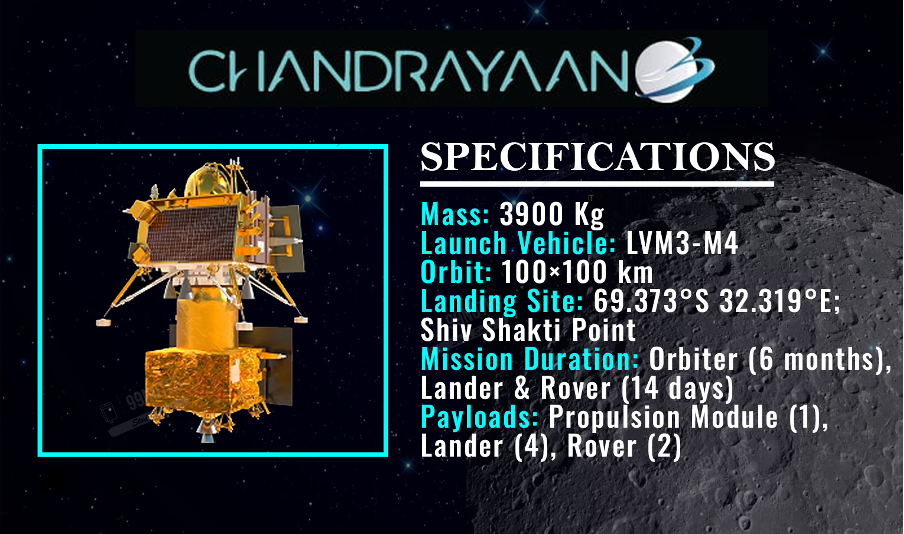
Mission Objectives
It aims to demonstrate end to end capability of landing and roving on the surface of the Moon and conducting in-situ scientific experiments on the lunar surface.
Mission Timeline and Profile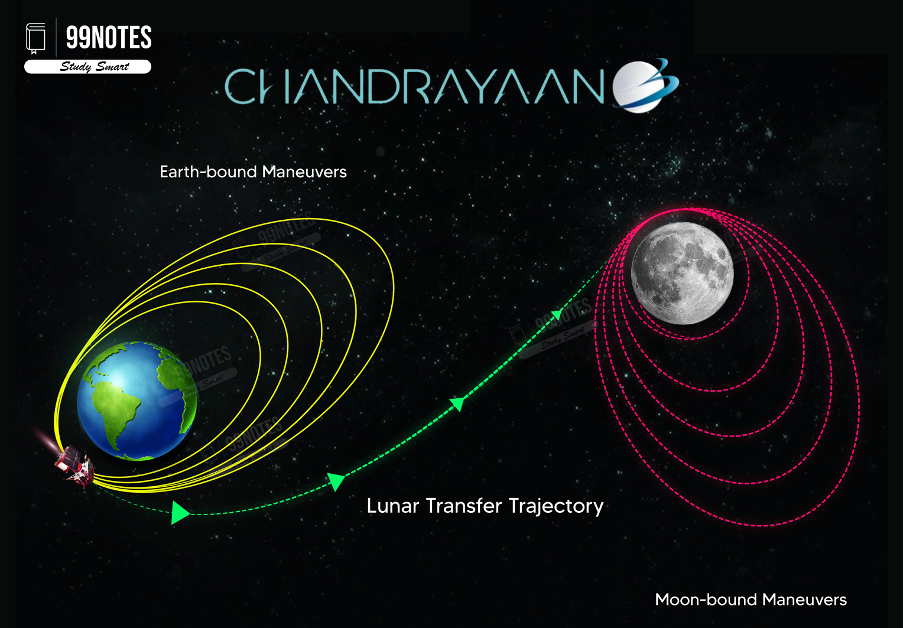
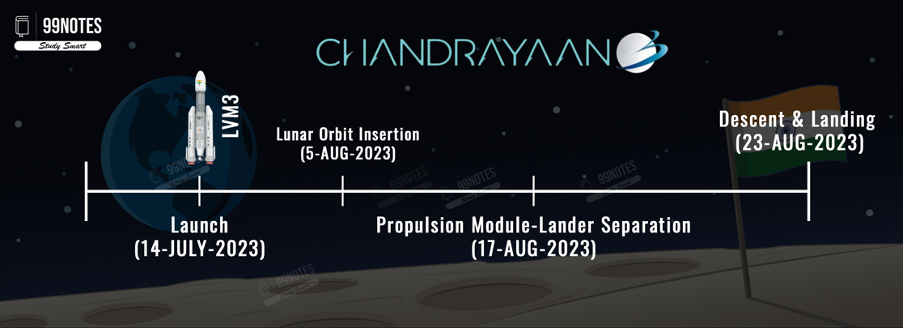
Instruments
Both the Lander and the Rover have the same set of scientific instruments as the previous one. The Propulsion module, which will carry the Lander and Rover configuration to the Moon, also has a scientific payload.
SHAPE: The propulsion module has a Spectro-polarimetry of Habitable Planet Earth (SHAPE) payload to study the spectral and Polari metric measurements of Earth from the lunar orbit.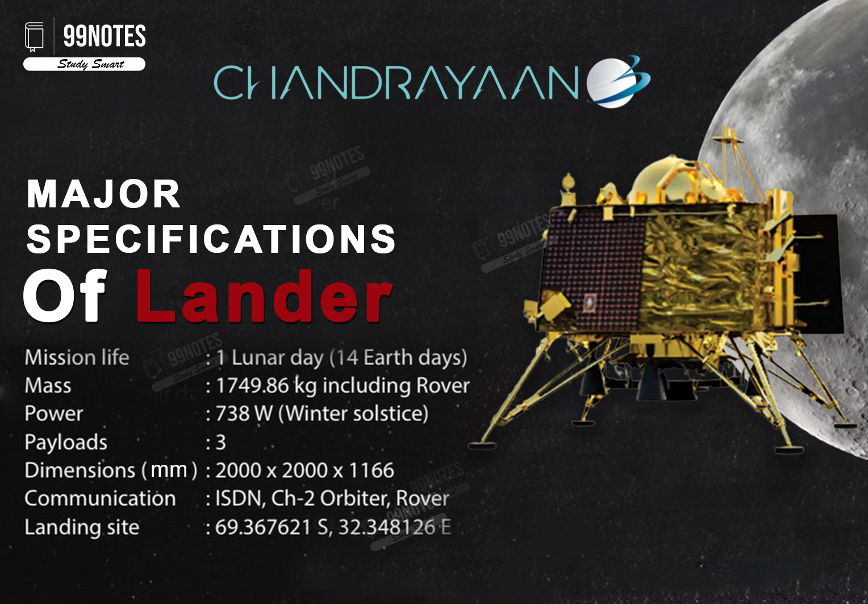
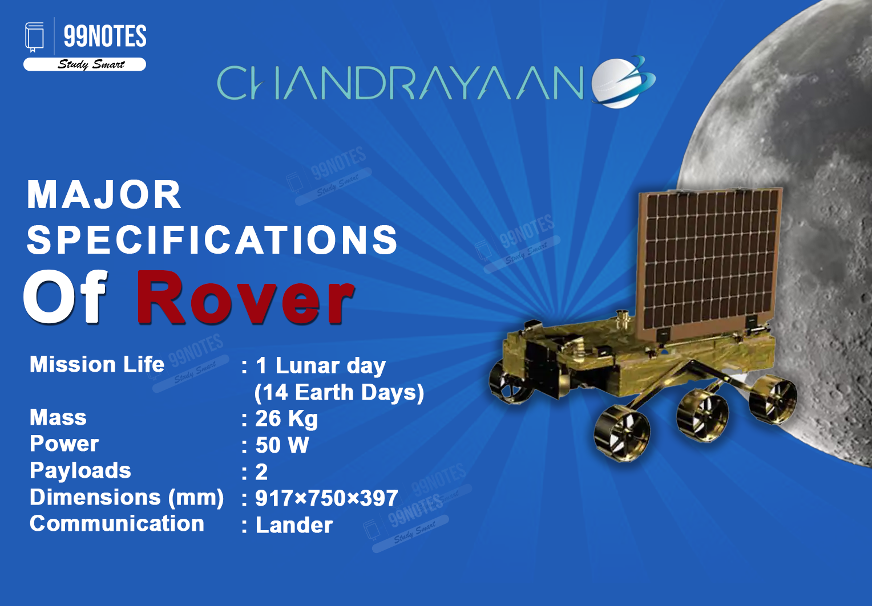
Vikram Lander Descent Profile
How is Chandrayaan-3 Different from Chandrayaan-2
- The previous Chandrayaan Mission was in an Orbiter, Lander and Rover configuration, whereas in this Mission, there is no functional orbiter; instead, there is a Propulsion module that carries the Lander-Rover Configuration to the Moon.
- This time, the Lander has been equipped with additional redundancies such as extra fuel, stronger landing legs, extra hazard avoidance cameras and additional sensors such as Laser Doppler velocimeter.
- The landing area has been increased to 5km×2.5 km from earlier 500m×500m.
- In this Mission, only four throttleable liquid engines are being used, instead of five engines in the previous missions.
Scientific Findings
- ChASTE (Chandra’s Surface Thermophysical Experiment): This instrument has sent the temperature profile of the Moon’s surface and sub-surface, indicating drastic temperature variations.

- Laser-Induced Breakdown Spectroscopy (LIBS): The LIBS instrument has discovered the unambiguous presence of sulphur on the Moon, along with other minerals.
- Besides these findings, the ISRO has also published the initial findings of the Alpha-Particle X-ray Spectrometer (APXS) instrument and Radio Anatomy for Moon-bound Hyper-sensitive Ionosphere and Atmosphere (RAMBHA)
Future Missions under the Lunar Explorations Programme
Under the Chandrayaan Programme, the ISRO has plans for more landing missions with bigger payloads and even more sophisticated instruments. There are also plans for lunar soil sample return missions.
The next lunar exploration programme, LUPEX (Lunar Polar Exploration), is a joint collaboration between ISRO and Japanese space Agency JAXA. The mission involves a lunar lander and rover configuration, in which the Lander and some instruments on the rover will be provided by ISRO. The Mission will launched aboard the Japanese H3 rocket.
However, the Mission is in the pre-approval phase, and the mission profile is yet to be finalised.
Source- JAXA


